Unilever's Global Marketing Management Strategy in the Gulf Region
VerifiedAdded on 2023/04/21
|21
|5415
|401
Report
AI Summary
This report provides an overview of global marketing management for a FMCG multinational company, specifically Unilever, in the Gulf region. It analyzes the macro environment using PESTEL analysis, Maslow's hierarchy of needs, and Hofstede's cultural framework, highlighting similarities and differences between countries in the region. The report discusses the appropriateness of global versus multi-domestic marketing strategies and examines the standardization and adaptation of marketing activities, focusing on product, communication, and distribution elements of the marketing mix. It concludes with recommendations for enhancing Unilever's marketing operations in the Gulf region, emphasizing synergy and strategic alignment.
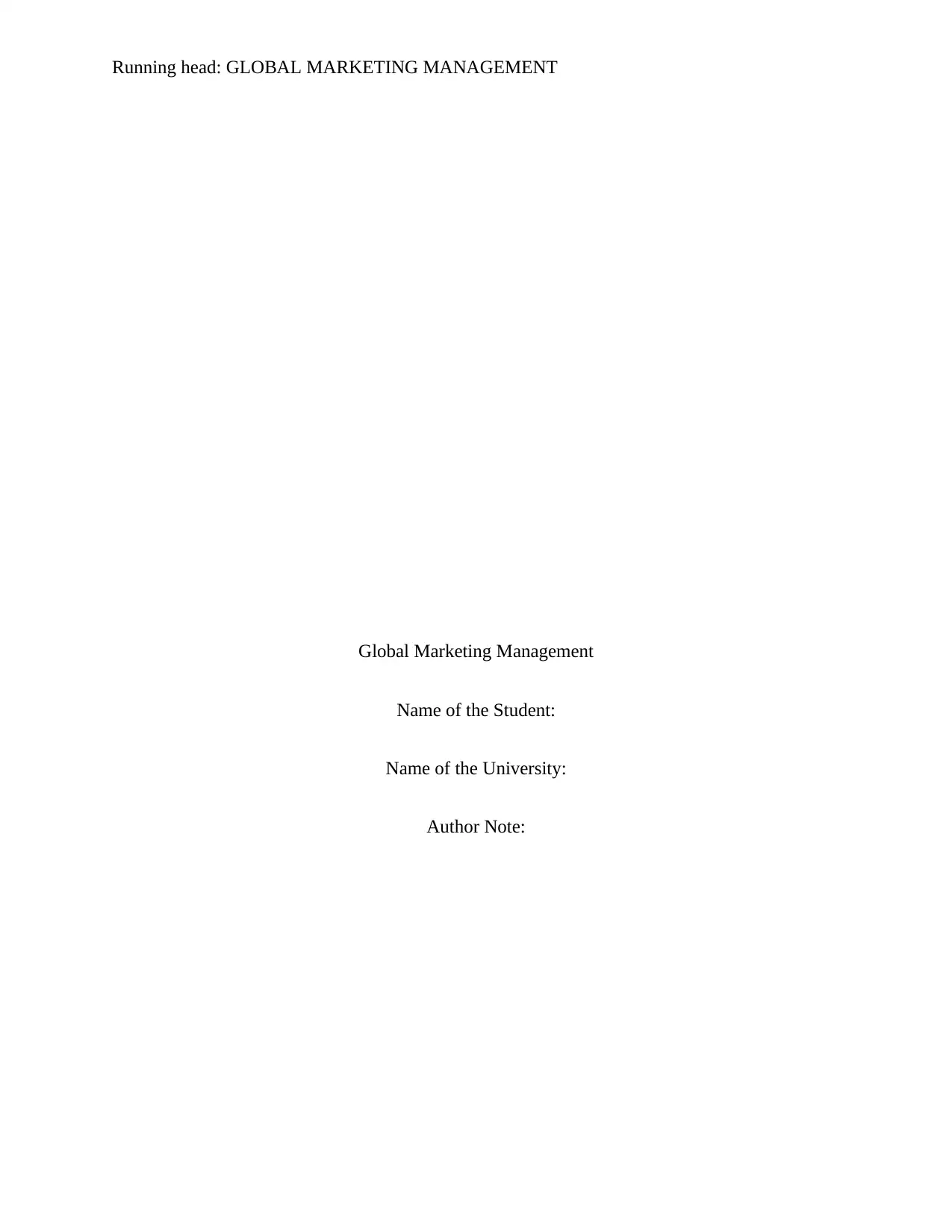
Running head: GLOBAL MARKETING MANAGEMENT
Global Marketing Management
Name of the Student:
Name of the University:
Author Note:
Global Marketing Management
Name of the Student:
Name of the University:
Author Note:
Paraphrase This Document
Need a fresh take? Get an instant paraphrase of this document with our AI Paraphraser
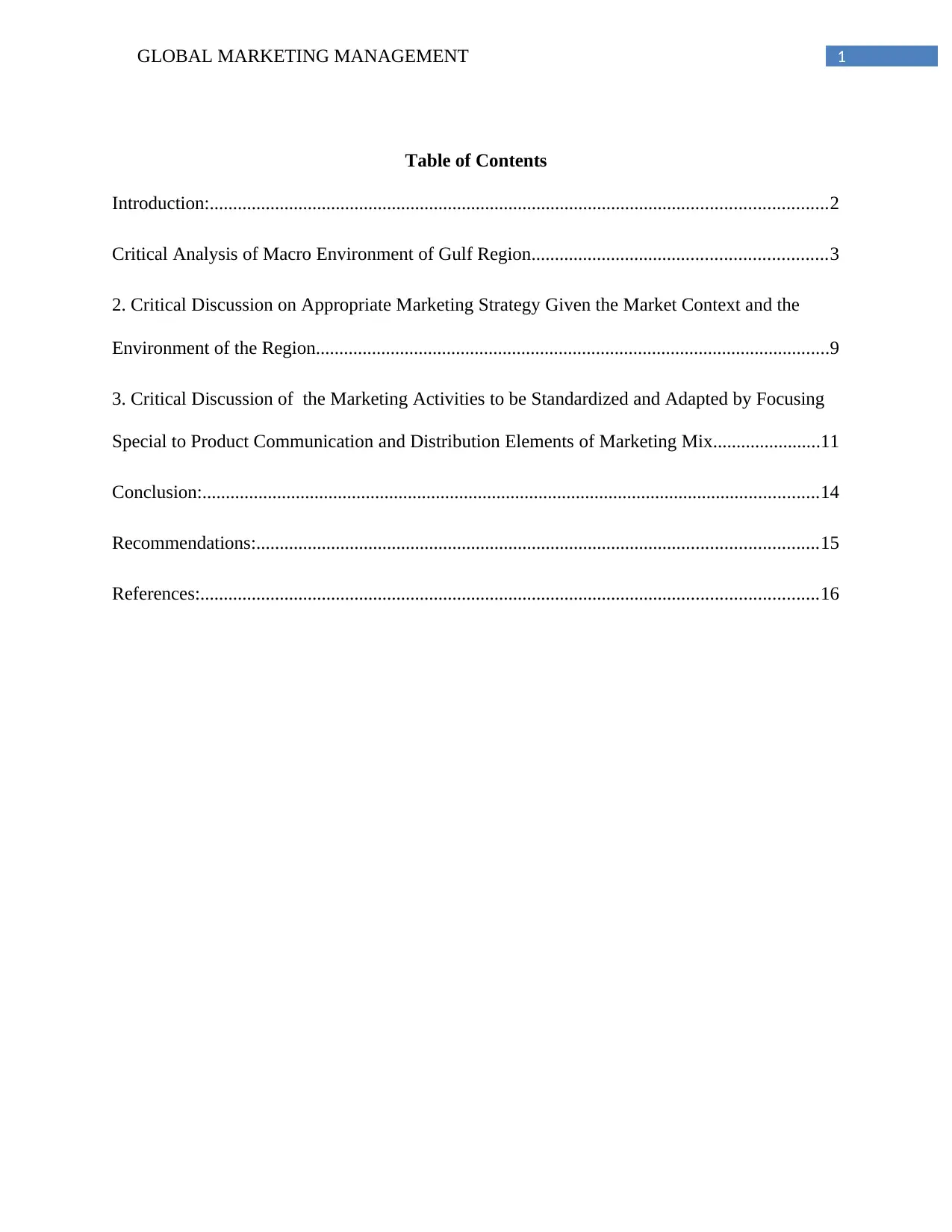
1GLOBAL MARKETING MANAGEMENT
Table of Contents
Introduction:....................................................................................................................................2
Critical Analysis of Macro Environment of Gulf Region...............................................................3
2. Critical Discussion on Appropriate Marketing Strategy Given the Market Context and the
Environment of the Region..............................................................................................................9
3. Critical Discussion of the Marketing Activities to be Standardized and Adapted by Focusing
Special to Product Communication and Distribution Elements of Marketing Mix.......................11
Conclusion:....................................................................................................................................14
Recommendations:........................................................................................................................15
References:....................................................................................................................................16
Table of Contents
Introduction:....................................................................................................................................2
Critical Analysis of Macro Environment of Gulf Region...............................................................3
2. Critical Discussion on Appropriate Marketing Strategy Given the Market Context and the
Environment of the Region..............................................................................................................9
3. Critical Discussion of the Marketing Activities to be Standardized and Adapted by Focusing
Special to Product Communication and Distribution Elements of Marketing Mix.......................11
Conclusion:....................................................................................................................................14
Recommendations:........................................................................................................................15
References:....................................................................................................................................16
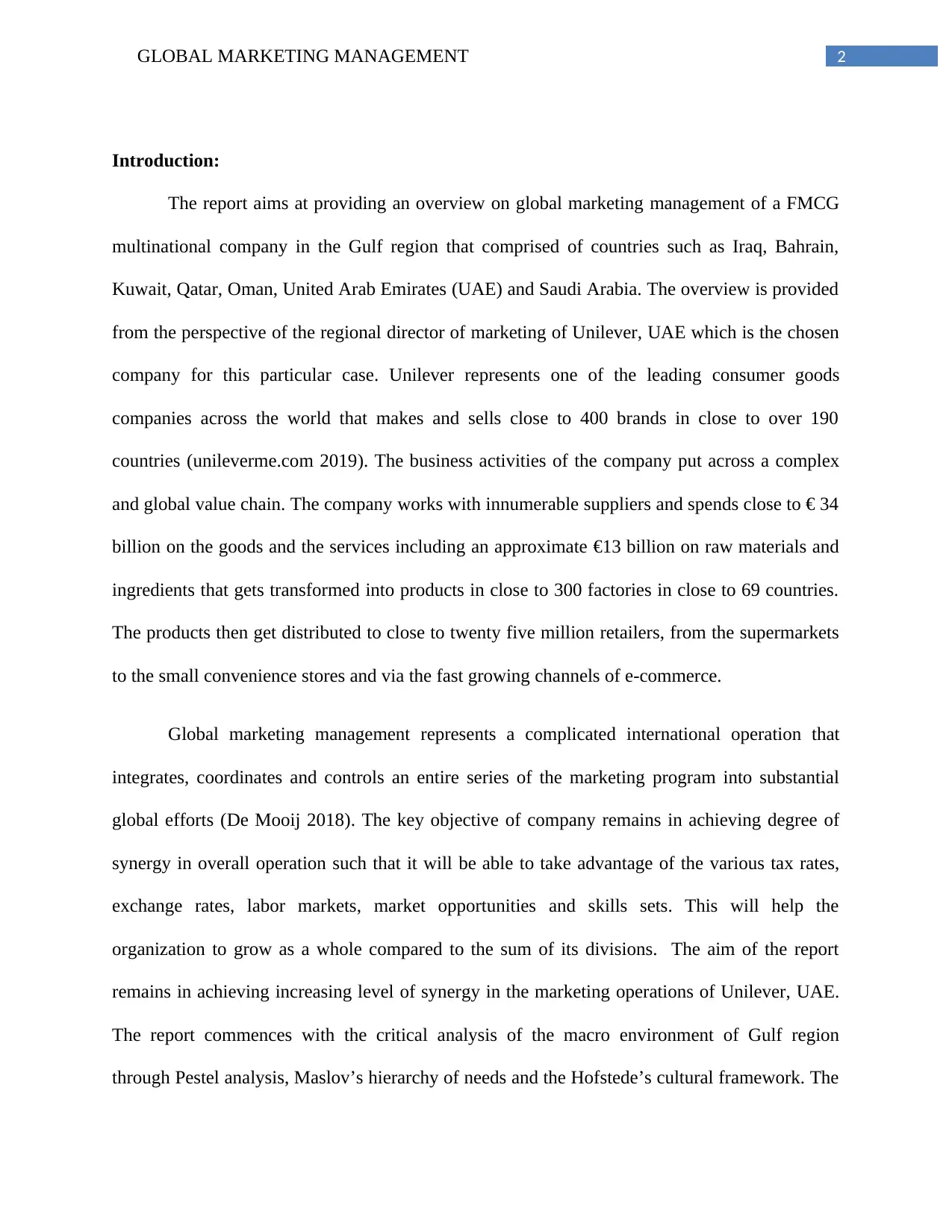
2GLOBAL MARKETING MANAGEMENT
Introduction:
The report aims at providing an overview on global marketing management of a FMCG
multinational company in the Gulf region that comprised of countries such as Iraq, Bahrain,
Kuwait, Qatar, Oman, United Arab Emirates (UAE) and Saudi Arabia. The overview is provided
from the perspective of the regional director of marketing of Unilever, UAE which is the chosen
company for this particular case. Unilever represents one of the leading consumer goods
companies across the world that makes and sells close to 400 brands in close to over 190
countries (unileverme.com 2019). The business activities of the company put across a complex
and global value chain. The company works with innumerable suppliers and spends close to € 34
billion on the goods and the services including an approximate €13 billion on raw materials and
ingredients that gets transformed into products in close to 300 factories in close to 69 countries.
The products then get distributed to close to twenty five million retailers, from the supermarkets
to the small convenience stores and via the fast growing channels of e-commerce.
Global marketing management represents a complicated international operation that
integrates, coordinates and controls an entire series of the marketing program into substantial
global efforts (De Mooij 2018). The key objective of company remains in achieving degree of
synergy in overall operation such that it will be able to take advantage of the various tax rates,
exchange rates, labor markets, market opportunities and skills sets. This will help the
organization to grow as a whole compared to the sum of its divisions. The aim of the report
remains in achieving increasing level of synergy in the marketing operations of Unilever, UAE.
The report commences with the critical analysis of the macro environment of Gulf region
through Pestel analysis, Maslov’s hierarchy of needs and the Hofstede’s cultural framework. The
Introduction:
The report aims at providing an overview on global marketing management of a FMCG
multinational company in the Gulf region that comprised of countries such as Iraq, Bahrain,
Kuwait, Qatar, Oman, United Arab Emirates (UAE) and Saudi Arabia. The overview is provided
from the perspective of the regional director of marketing of Unilever, UAE which is the chosen
company for this particular case. Unilever represents one of the leading consumer goods
companies across the world that makes and sells close to 400 brands in close to over 190
countries (unileverme.com 2019). The business activities of the company put across a complex
and global value chain. The company works with innumerable suppliers and spends close to € 34
billion on the goods and the services including an approximate €13 billion on raw materials and
ingredients that gets transformed into products in close to 300 factories in close to 69 countries.
The products then get distributed to close to twenty five million retailers, from the supermarkets
to the small convenience stores and via the fast growing channels of e-commerce.
Global marketing management represents a complicated international operation that
integrates, coordinates and controls an entire series of the marketing program into substantial
global efforts (De Mooij 2018). The key objective of company remains in achieving degree of
synergy in overall operation such that it will be able to take advantage of the various tax rates,
exchange rates, labor markets, market opportunities and skills sets. This will help the
organization to grow as a whole compared to the sum of its divisions. The aim of the report
remains in achieving increasing level of synergy in the marketing operations of Unilever, UAE.
The report commences with the critical analysis of the macro environment of Gulf region
through Pestel analysis, Maslov’s hierarchy of needs and the Hofstede’s cultural framework. The
⊘ This is a preview!⊘
Do you want full access?
Subscribe today to unlock all pages.

Trusted by 1+ million students worldwide
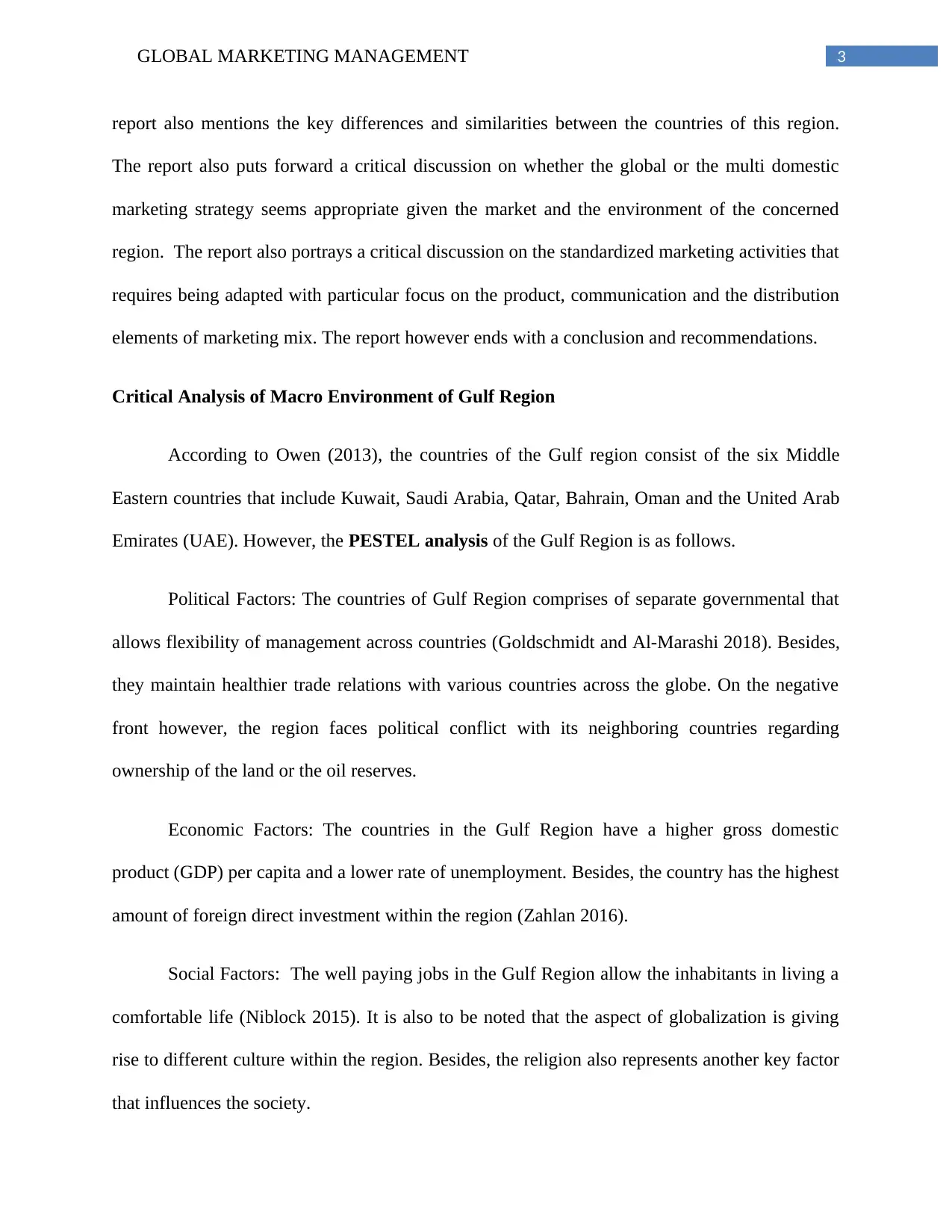
3GLOBAL MARKETING MANAGEMENT
report also mentions the key differences and similarities between the countries of this region.
The report also puts forward a critical discussion on whether the global or the multi domestic
marketing strategy seems appropriate given the market and the environment of the concerned
region. The report also portrays a critical discussion on the standardized marketing activities that
requires being adapted with particular focus on the product, communication and the distribution
elements of marketing mix. The report however ends with a conclusion and recommendations.
Critical Analysis of Macro Environment of Gulf Region
According to Owen (2013), the countries of the Gulf region consist of the six Middle
Eastern countries that include Kuwait, Saudi Arabia, Qatar, Bahrain, Oman and the United Arab
Emirates (UAE). However, the PESTEL analysis of the Gulf Region is as follows.
Political Factors: The countries of Gulf Region comprises of separate governmental that
allows flexibility of management across countries (Goldschmidt and Al-Marashi 2018). Besides,
they maintain healthier trade relations with various countries across the globe. On the negative
front however, the region faces political conflict with its neighboring countries regarding
ownership of the land or the oil reserves.
Economic Factors: The countries in the Gulf Region have a higher gross domestic
product (GDP) per capita and a lower rate of unemployment. Besides, the country has the highest
amount of foreign direct investment within the region (Zahlan 2016).
Social Factors: The well paying jobs in the Gulf Region allow the inhabitants in living a
comfortable life (Niblock 2015). It is also to be noted that the aspect of globalization is giving
rise to different culture within the region. Besides, the religion also represents another key factor
that influences the society.
report also mentions the key differences and similarities between the countries of this region.
The report also puts forward a critical discussion on whether the global or the multi domestic
marketing strategy seems appropriate given the market and the environment of the concerned
region. The report also portrays a critical discussion on the standardized marketing activities that
requires being adapted with particular focus on the product, communication and the distribution
elements of marketing mix. The report however ends with a conclusion and recommendations.
Critical Analysis of Macro Environment of Gulf Region
According to Owen (2013), the countries of the Gulf region consist of the six Middle
Eastern countries that include Kuwait, Saudi Arabia, Qatar, Bahrain, Oman and the United Arab
Emirates (UAE). However, the PESTEL analysis of the Gulf Region is as follows.
Political Factors: The countries of Gulf Region comprises of separate governmental that
allows flexibility of management across countries (Goldschmidt and Al-Marashi 2018). Besides,
they maintain healthier trade relations with various countries across the globe. On the negative
front however, the region faces political conflict with its neighboring countries regarding
ownership of the land or the oil reserves.
Economic Factors: The countries in the Gulf Region have a higher gross domestic
product (GDP) per capita and a lower rate of unemployment. Besides, the country has the highest
amount of foreign direct investment within the region (Zahlan 2016).
Social Factors: The well paying jobs in the Gulf Region allow the inhabitants in living a
comfortable life (Niblock 2015). It is also to be noted that the aspect of globalization is giving
rise to different culture within the region. Besides, the religion also represents another key factor
that influences the society.
Paraphrase This Document
Need a fresh take? Get an instant paraphrase of this document with our AI Paraphraser
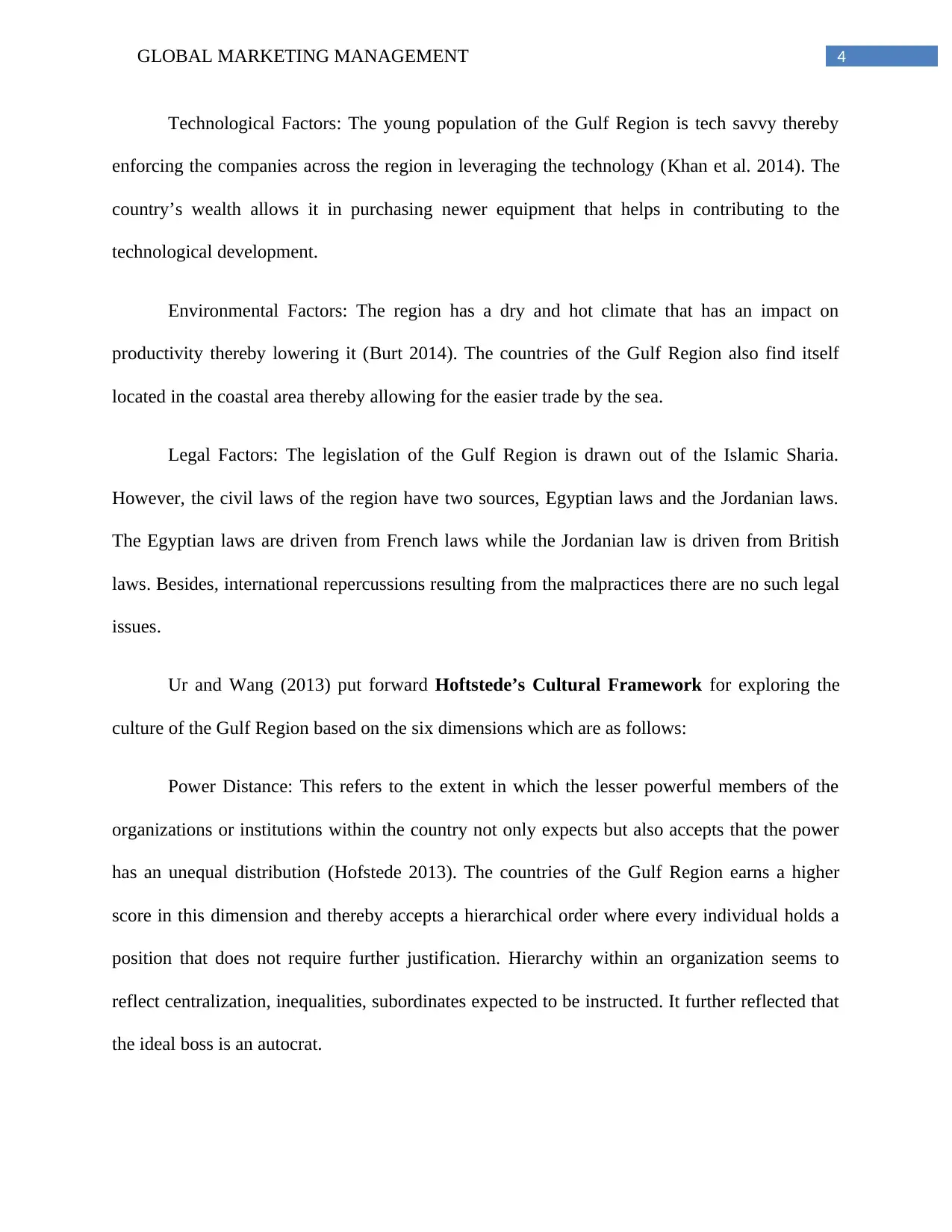
4GLOBAL MARKETING MANAGEMENT
Technological Factors: The young population of the Gulf Region is tech savvy thereby
enforcing the companies across the region in leveraging the technology (Khan et al. 2014). The
country’s wealth allows it in purchasing newer equipment that helps in contributing to the
technological development.
Environmental Factors: The region has a dry and hot climate that has an impact on
productivity thereby lowering it (Burt 2014). The countries of the Gulf Region also find itself
located in the coastal area thereby allowing for the easier trade by the sea.
Legal Factors: The legislation of the Gulf Region is drawn out of the Islamic Sharia.
However, the civil laws of the region have two sources, Egyptian laws and the Jordanian laws.
The Egyptian laws are driven from French laws while the Jordanian law is driven from British
laws. Besides, international repercussions resulting from the malpractices there are no such legal
issues.
Ur and Wang (2013) put forward Hoftstede’s Cultural Framework for exploring the
culture of the Gulf Region based on the six dimensions which are as follows:
Power Distance: This refers to the extent in which the lesser powerful members of the
organizations or institutions within the country not only expects but also accepts that the power
has an unequal distribution (Hofstede 2013). The countries of the Gulf Region earns a higher
score in this dimension and thereby accepts a hierarchical order where every individual holds a
position that does not require further justification. Hierarchy within an organization seems to
reflect centralization, inequalities, subordinates expected to be instructed. It further reflected that
the ideal boss is an autocrat.
Technological Factors: The young population of the Gulf Region is tech savvy thereby
enforcing the companies across the region in leveraging the technology (Khan et al. 2014). The
country’s wealth allows it in purchasing newer equipment that helps in contributing to the
technological development.
Environmental Factors: The region has a dry and hot climate that has an impact on
productivity thereby lowering it (Burt 2014). The countries of the Gulf Region also find itself
located in the coastal area thereby allowing for the easier trade by the sea.
Legal Factors: The legislation of the Gulf Region is drawn out of the Islamic Sharia.
However, the civil laws of the region have two sources, Egyptian laws and the Jordanian laws.
The Egyptian laws are driven from French laws while the Jordanian law is driven from British
laws. Besides, international repercussions resulting from the malpractices there are no such legal
issues.
Ur and Wang (2013) put forward Hoftstede’s Cultural Framework for exploring the
culture of the Gulf Region based on the six dimensions which are as follows:
Power Distance: This refers to the extent in which the lesser powerful members of the
organizations or institutions within the country not only expects but also accepts that the power
has an unequal distribution (Hofstede 2013). The countries of the Gulf Region earns a higher
score in this dimension and thereby accepts a hierarchical order where every individual holds a
position that does not require further justification. Hierarchy within an organization seems to
reflect centralization, inequalities, subordinates expected to be instructed. It further reflected that
the ideal boss is an autocrat.
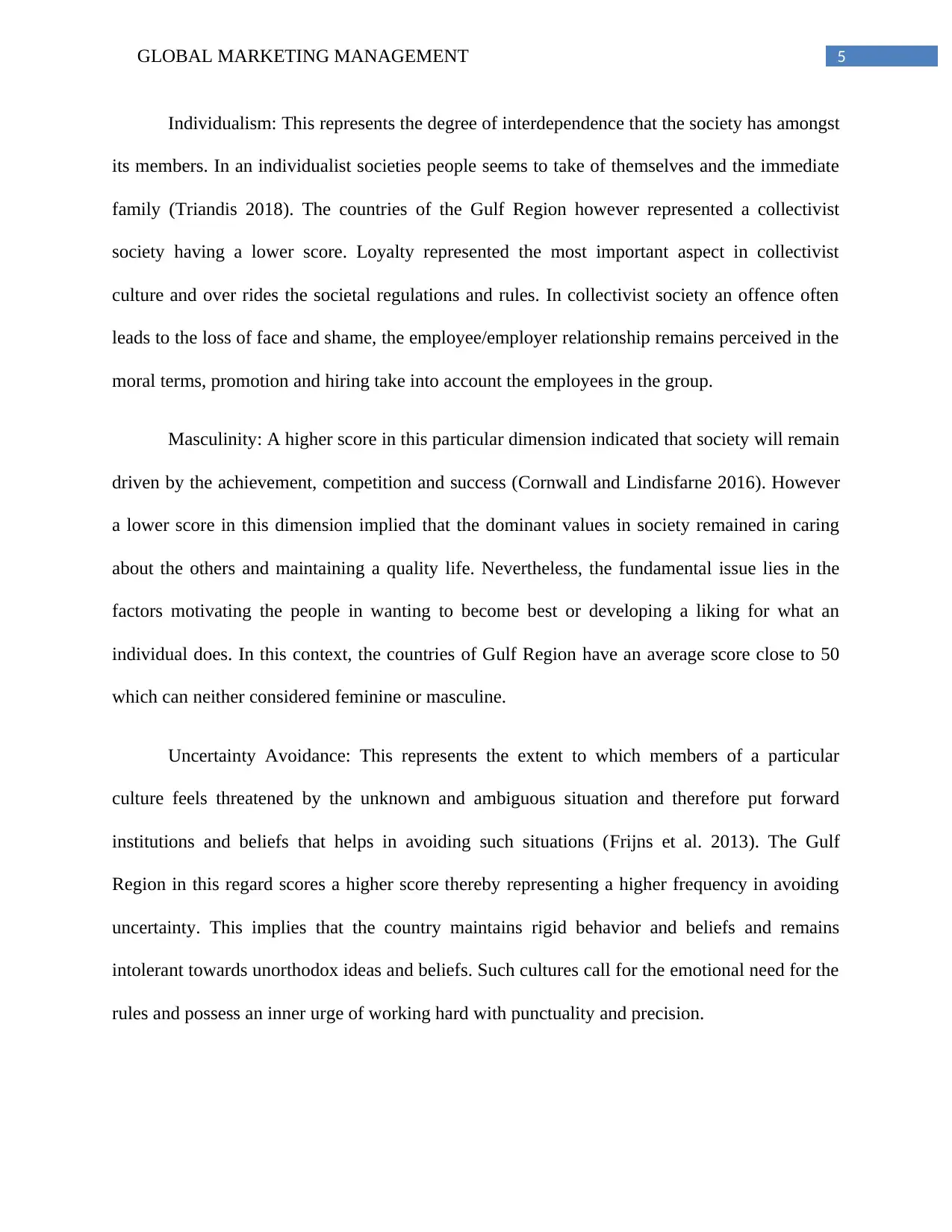
5GLOBAL MARKETING MANAGEMENT
Individualism: This represents the degree of interdependence that the society has amongst
its members. In an individualist societies people seems to take of themselves and the immediate
family (Triandis 2018). The countries of the Gulf Region however represented a collectivist
society having a lower score. Loyalty represented the most important aspect in collectivist
culture and over rides the societal regulations and rules. In collectivist society an offence often
leads to the loss of face and shame, the employee/employer relationship remains perceived in the
moral terms, promotion and hiring take into account the employees in the group.
Masculinity: A higher score in this particular dimension indicated that society will remain
driven by the achievement, competition and success (Cornwall and Lindisfarne 2016). However
a lower score in this dimension implied that the dominant values in society remained in caring
about the others and maintaining a quality life. Nevertheless, the fundamental issue lies in the
factors motivating the people in wanting to become best or developing a liking for what an
individual does. In this context, the countries of Gulf Region have an average score close to 50
which can neither considered feminine or masculine.
Uncertainty Avoidance: This represents the extent to which members of a particular
culture feels threatened by the unknown and ambiguous situation and therefore put forward
institutions and beliefs that helps in avoiding such situations (Frijns et al. 2013). The Gulf
Region in this regard scores a higher score thereby representing a higher frequency in avoiding
uncertainty. This implies that the country maintains rigid behavior and beliefs and remains
intolerant towards unorthodox ideas and beliefs. Such cultures call for the emotional need for the
rules and possess an inner urge of working hard with punctuality and precision.
Individualism: This represents the degree of interdependence that the society has amongst
its members. In an individualist societies people seems to take of themselves and the immediate
family (Triandis 2018). The countries of the Gulf Region however represented a collectivist
society having a lower score. Loyalty represented the most important aspect in collectivist
culture and over rides the societal regulations and rules. In collectivist society an offence often
leads to the loss of face and shame, the employee/employer relationship remains perceived in the
moral terms, promotion and hiring take into account the employees in the group.
Masculinity: A higher score in this particular dimension indicated that society will remain
driven by the achievement, competition and success (Cornwall and Lindisfarne 2016). However
a lower score in this dimension implied that the dominant values in society remained in caring
about the others and maintaining a quality life. Nevertheless, the fundamental issue lies in the
factors motivating the people in wanting to become best or developing a liking for what an
individual does. In this context, the countries of Gulf Region have an average score close to 50
which can neither considered feminine or masculine.
Uncertainty Avoidance: This represents the extent to which members of a particular
culture feels threatened by the unknown and ambiguous situation and therefore put forward
institutions and beliefs that helps in avoiding such situations (Frijns et al. 2013). The Gulf
Region in this regard scores a higher score thereby representing a higher frequency in avoiding
uncertainty. This implies that the country maintains rigid behavior and beliefs and remains
intolerant towards unorthodox ideas and beliefs. Such cultures call for the emotional need for the
rules and possess an inner urge of working hard with punctuality and precision.
⊘ This is a preview!⊘
Do you want full access?
Subscribe today to unlock all pages.

Trusted by 1+ million students worldwide
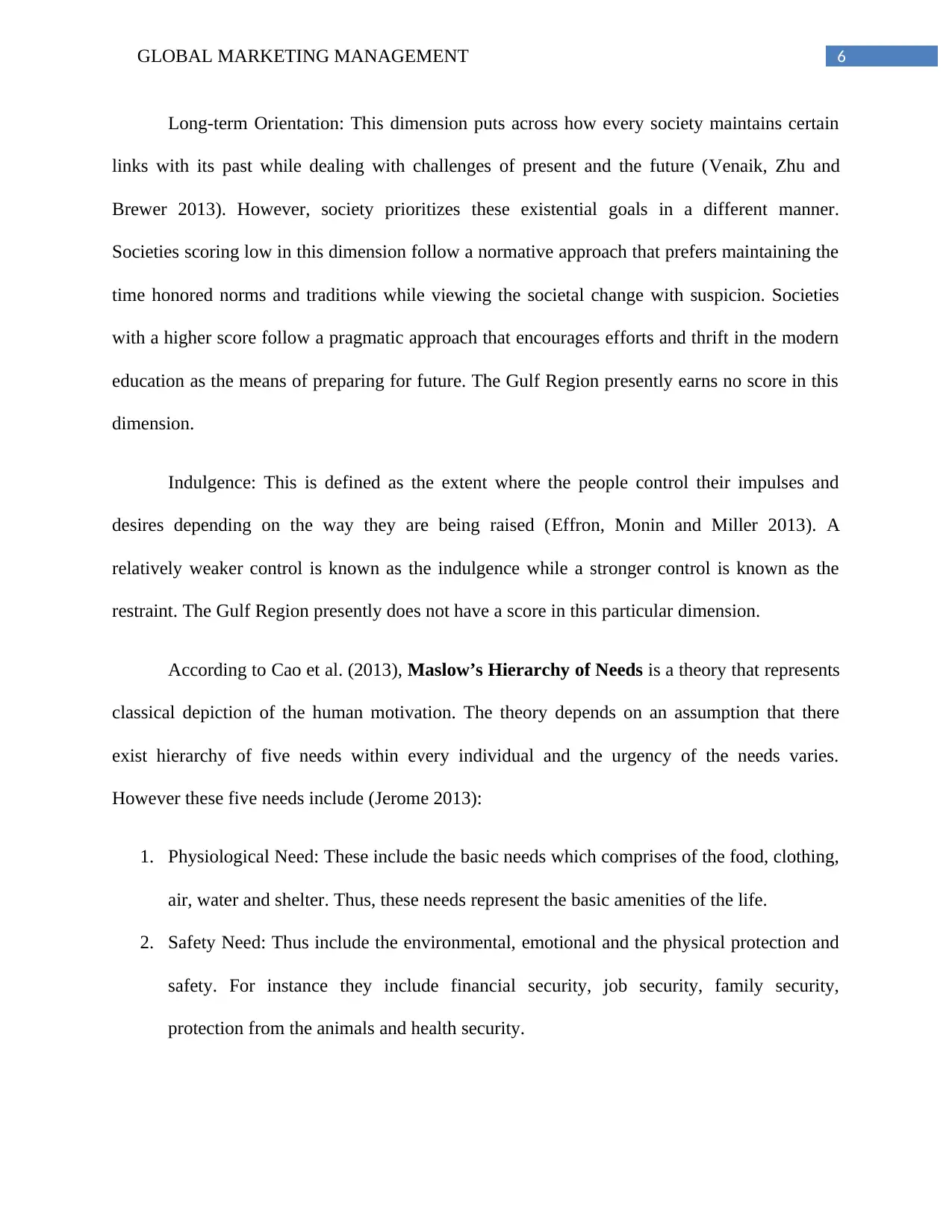
6GLOBAL MARKETING MANAGEMENT
Long-term Orientation: This dimension puts across how every society maintains certain
links with its past while dealing with challenges of present and the future (Venaik, Zhu and
Brewer 2013). However, society prioritizes these existential goals in a different manner.
Societies scoring low in this dimension follow a normative approach that prefers maintaining the
time honored norms and traditions while viewing the societal change with suspicion. Societies
with a higher score follow a pragmatic approach that encourages efforts and thrift in the modern
education as the means of preparing for future. The Gulf Region presently earns no score in this
dimension.
Indulgence: This is defined as the extent where the people control their impulses and
desires depending on the way they are being raised (Effron, Monin and Miller 2013). A
relatively weaker control is known as the indulgence while a stronger control is known as the
restraint. The Gulf Region presently does not have a score in this particular dimension.
According to Cao et al. (2013), Maslow’s Hierarchy of Needs is a theory that represents
classical depiction of the human motivation. The theory depends on an assumption that there
exist hierarchy of five needs within every individual and the urgency of the needs varies.
However these five needs include (Jerome 2013):
1. Physiological Need: These include the basic needs which comprises of the food, clothing,
air, water and shelter. Thus, these needs represent the basic amenities of the life.
2. Safety Need: Thus include the environmental, emotional and the physical protection and
safety. For instance they include financial security, job security, family security,
protection from the animals and health security.
Long-term Orientation: This dimension puts across how every society maintains certain
links with its past while dealing with challenges of present and the future (Venaik, Zhu and
Brewer 2013). However, society prioritizes these existential goals in a different manner.
Societies scoring low in this dimension follow a normative approach that prefers maintaining the
time honored norms and traditions while viewing the societal change with suspicion. Societies
with a higher score follow a pragmatic approach that encourages efforts and thrift in the modern
education as the means of preparing for future. The Gulf Region presently earns no score in this
dimension.
Indulgence: This is defined as the extent where the people control their impulses and
desires depending on the way they are being raised (Effron, Monin and Miller 2013). A
relatively weaker control is known as the indulgence while a stronger control is known as the
restraint. The Gulf Region presently does not have a score in this particular dimension.
According to Cao et al. (2013), Maslow’s Hierarchy of Needs is a theory that represents
classical depiction of the human motivation. The theory depends on an assumption that there
exist hierarchy of five needs within every individual and the urgency of the needs varies.
However these five needs include (Jerome 2013):
1. Physiological Need: These include the basic needs which comprises of the food, clothing,
air, water and shelter. Thus, these needs represent the basic amenities of the life.
2. Safety Need: Thus include the environmental, emotional and the physical protection and
safety. For instance they include financial security, job security, family security,
protection from the animals and health security.
Paraphrase This Document
Need a fresh take? Get an instant paraphrase of this document with our AI Paraphraser
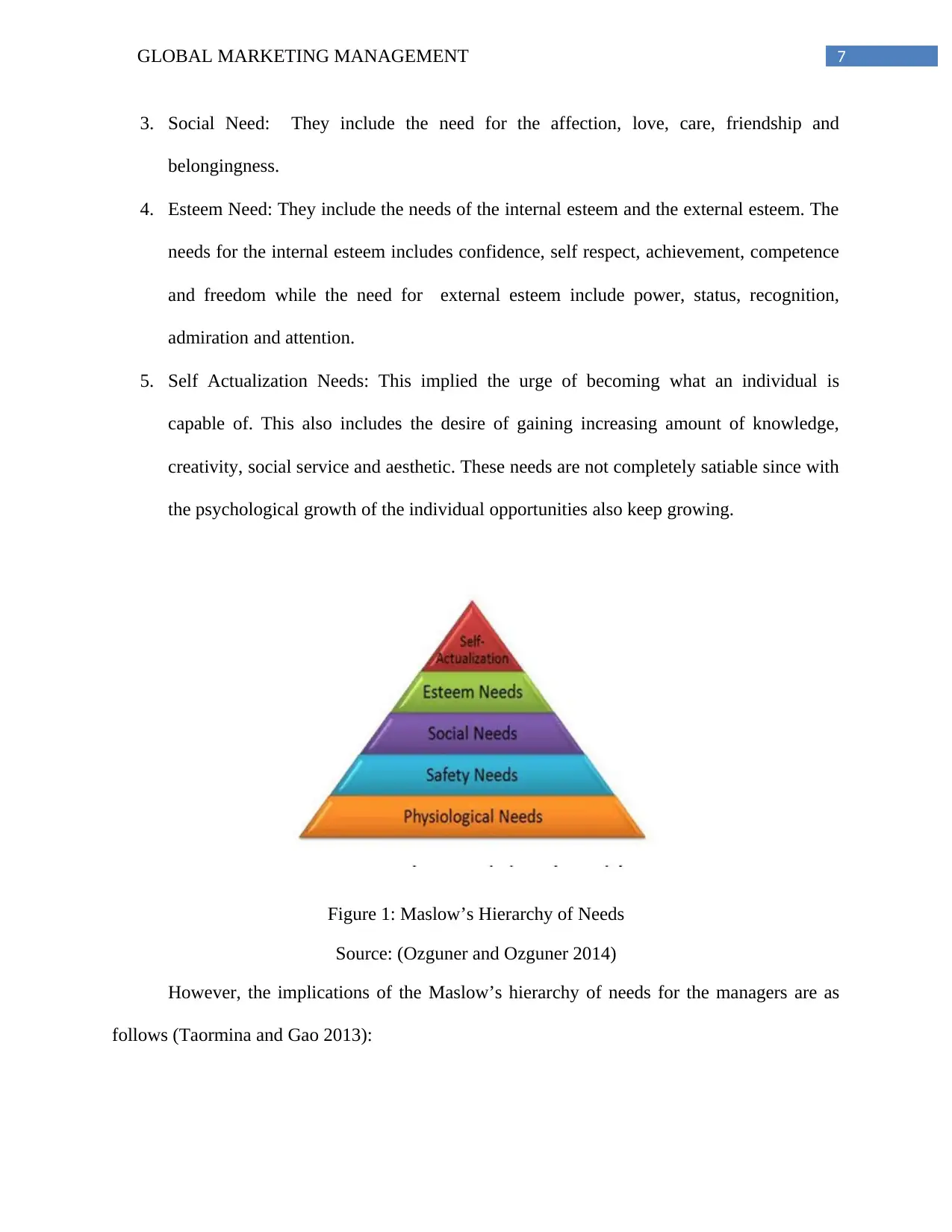
7GLOBAL MARKETING MANAGEMENT
3. Social Need: They include the need for the affection, love, care, friendship and
belongingness.
4. Esteem Need: They include the needs of the internal esteem and the external esteem. The
needs for the internal esteem includes confidence, self respect, achievement, competence
and freedom while the need for external esteem include power, status, recognition,
admiration and attention.
5. Self Actualization Needs: This implied the urge of becoming what an individual is
capable of. This also includes the desire of gaining increasing amount of knowledge,
creativity, social service and aesthetic. These needs are not completely satiable since with
the psychological growth of the individual opportunities also keep growing.
Figure 1: Maslow’s Hierarchy of Needs
Source: (Ozguner and Ozguner 2014)
However, the implications of the Maslow’s hierarchy of needs for the managers are as
follows (Taormina and Gao 2013):
3. Social Need: They include the need for the affection, love, care, friendship and
belongingness.
4. Esteem Need: They include the needs of the internal esteem and the external esteem. The
needs for the internal esteem includes confidence, self respect, achievement, competence
and freedom while the need for external esteem include power, status, recognition,
admiration and attention.
5. Self Actualization Needs: This implied the urge of becoming what an individual is
capable of. This also includes the desire of gaining increasing amount of knowledge,
creativity, social service and aesthetic. These needs are not completely satiable since with
the psychological growth of the individual opportunities also keep growing.
Figure 1: Maslow’s Hierarchy of Needs
Source: (Ozguner and Ozguner 2014)
However, the implications of the Maslow’s hierarchy of needs for the managers are as
follows (Taormina and Gao 2013):
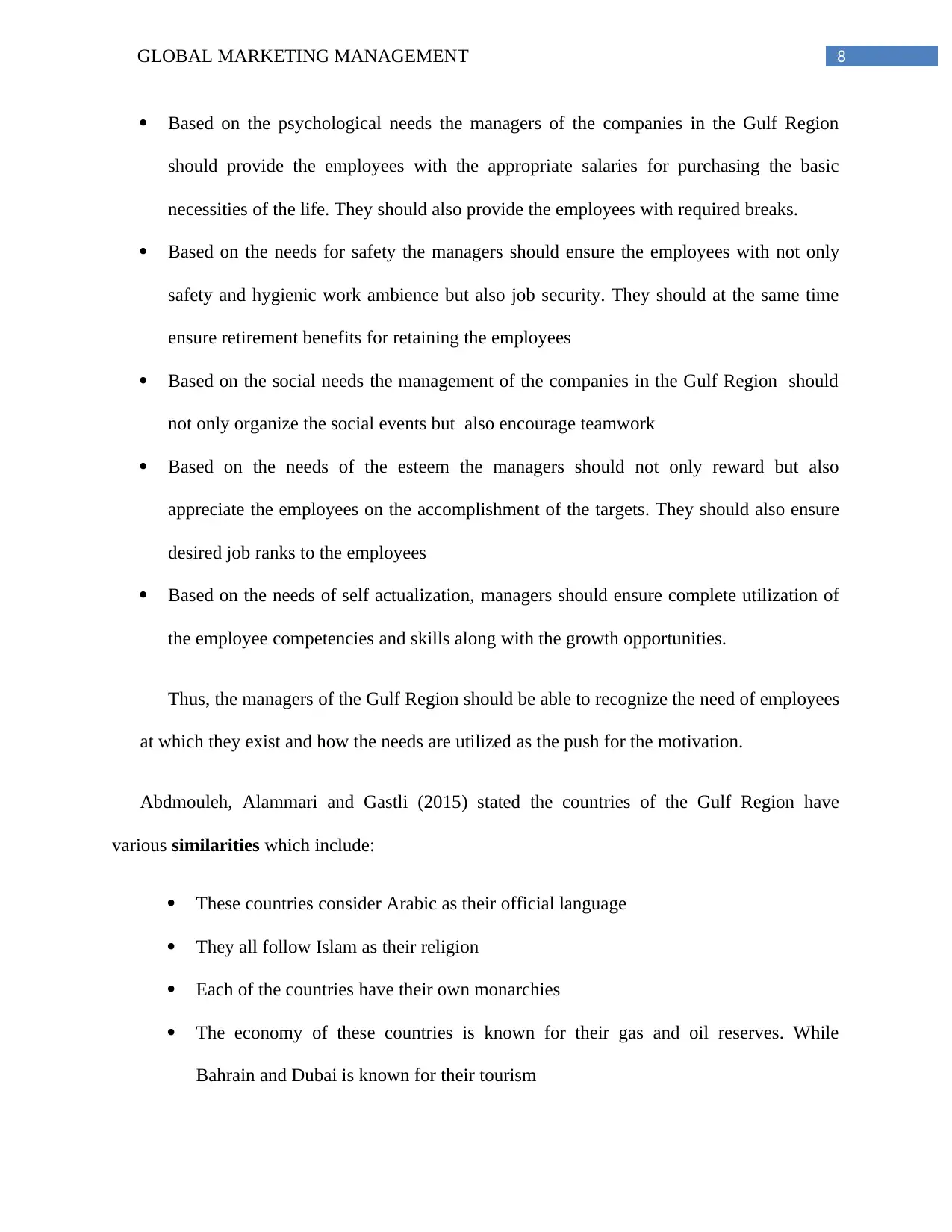
8GLOBAL MARKETING MANAGEMENT
Based on the psychological needs the managers of the companies in the Gulf Region
should provide the employees with the appropriate salaries for purchasing the basic
necessities of the life. They should also provide the employees with required breaks.
Based on the needs for safety the managers should ensure the employees with not only
safety and hygienic work ambience but also job security. They should at the same time
ensure retirement benefits for retaining the employees
Based on the social needs the management of the companies in the Gulf Region should
not only organize the social events but also encourage teamwork
Based on the needs of the esteem the managers should not only reward but also
appreciate the employees on the accomplishment of the targets. They should also ensure
desired job ranks to the employees
Based on the needs of self actualization, managers should ensure complete utilization of
the employee competencies and skills along with the growth opportunities.
Thus, the managers of the Gulf Region should be able to recognize the need of employees
at which they exist and how the needs are utilized as the push for the motivation.
Abdmouleh, Alammari and Gastli (2015) stated the countries of the Gulf Region have
various similarities which include:
These countries consider Arabic as their official language
They all follow Islam as their religion
Each of the countries have their own monarchies
The economy of these countries is known for their gas and oil reserves. While
Bahrain and Dubai is known for their tourism
Based on the psychological needs the managers of the companies in the Gulf Region
should provide the employees with the appropriate salaries for purchasing the basic
necessities of the life. They should also provide the employees with required breaks.
Based on the needs for safety the managers should ensure the employees with not only
safety and hygienic work ambience but also job security. They should at the same time
ensure retirement benefits for retaining the employees
Based on the social needs the management of the companies in the Gulf Region should
not only organize the social events but also encourage teamwork
Based on the needs of the esteem the managers should not only reward but also
appreciate the employees on the accomplishment of the targets. They should also ensure
desired job ranks to the employees
Based on the needs of self actualization, managers should ensure complete utilization of
the employee competencies and skills along with the growth opportunities.
Thus, the managers of the Gulf Region should be able to recognize the need of employees
at which they exist and how the needs are utilized as the push for the motivation.
Abdmouleh, Alammari and Gastli (2015) stated the countries of the Gulf Region have
various similarities which include:
These countries consider Arabic as their official language
They all follow Islam as their religion
Each of the countries have their own monarchies
The economy of these countries is known for their gas and oil reserves. While
Bahrain and Dubai is known for their tourism
⊘ This is a preview!⊘
Do you want full access?
Subscribe today to unlock all pages.

Trusted by 1+ million students worldwide
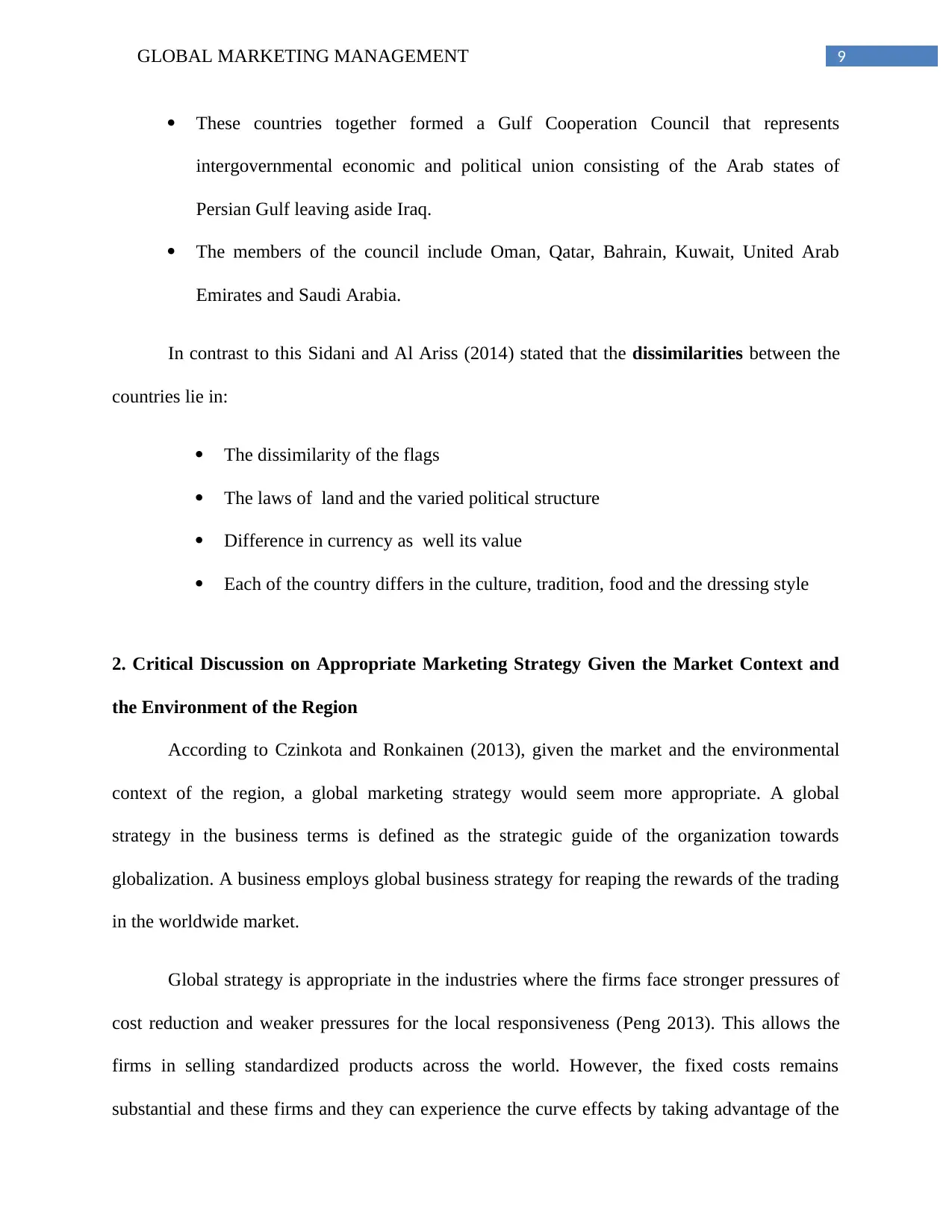
9GLOBAL MARKETING MANAGEMENT
These countries together formed a Gulf Cooperation Council that represents
intergovernmental economic and political union consisting of the Arab states of
Persian Gulf leaving aside Iraq.
The members of the council include Oman, Qatar, Bahrain, Kuwait, United Arab
Emirates and Saudi Arabia.
In contrast to this Sidani and Al Ariss (2014) stated that the dissimilarities between the
countries lie in:
The dissimilarity of the flags
The laws of land and the varied political structure
Difference in currency as well its value
Each of the country differs in the culture, tradition, food and the dressing style
2. Critical Discussion on Appropriate Marketing Strategy Given the Market Context and
the Environment of the Region
According to Czinkota and Ronkainen (2013), given the market and the environmental
context of the region, a global marketing strategy would seem more appropriate. A global
strategy in the business terms is defined as the strategic guide of the organization towards
globalization. A business employs global business strategy for reaping the rewards of the trading
in the worldwide market.
Global strategy is appropriate in the industries where the firms face stronger pressures of
cost reduction and weaker pressures for the local responsiveness (Peng 2013). This allows the
firms in selling standardized products across the world. However, the fixed costs remains
substantial and these firms and they can experience the curve effects by taking advantage of the
These countries together formed a Gulf Cooperation Council that represents
intergovernmental economic and political union consisting of the Arab states of
Persian Gulf leaving aside Iraq.
The members of the council include Oman, Qatar, Bahrain, Kuwait, United Arab
Emirates and Saudi Arabia.
In contrast to this Sidani and Al Ariss (2014) stated that the dissimilarities between the
countries lie in:
The dissimilarity of the flags
The laws of land and the varied political structure
Difference in currency as well its value
Each of the country differs in the culture, tradition, food and the dressing style
2. Critical Discussion on Appropriate Marketing Strategy Given the Market Context and
the Environment of the Region
According to Czinkota and Ronkainen (2013), given the market and the environmental
context of the region, a global marketing strategy would seem more appropriate. A global
strategy in the business terms is defined as the strategic guide of the organization towards
globalization. A business employs global business strategy for reaping the rewards of the trading
in the worldwide market.
Global strategy is appropriate in the industries where the firms face stronger pressures of
cost reduction and weaker pressures for the local responsiveness (Peng 2013). This allows the
firms in selling standardized products across the world. However, the fixed costs remains
substantial and these firms and they can experience the curve effects by taking advantage of the
Paraphrase This Document
Need a fresh take? Get an instant paraphrase of this document with our AI Paraphraser
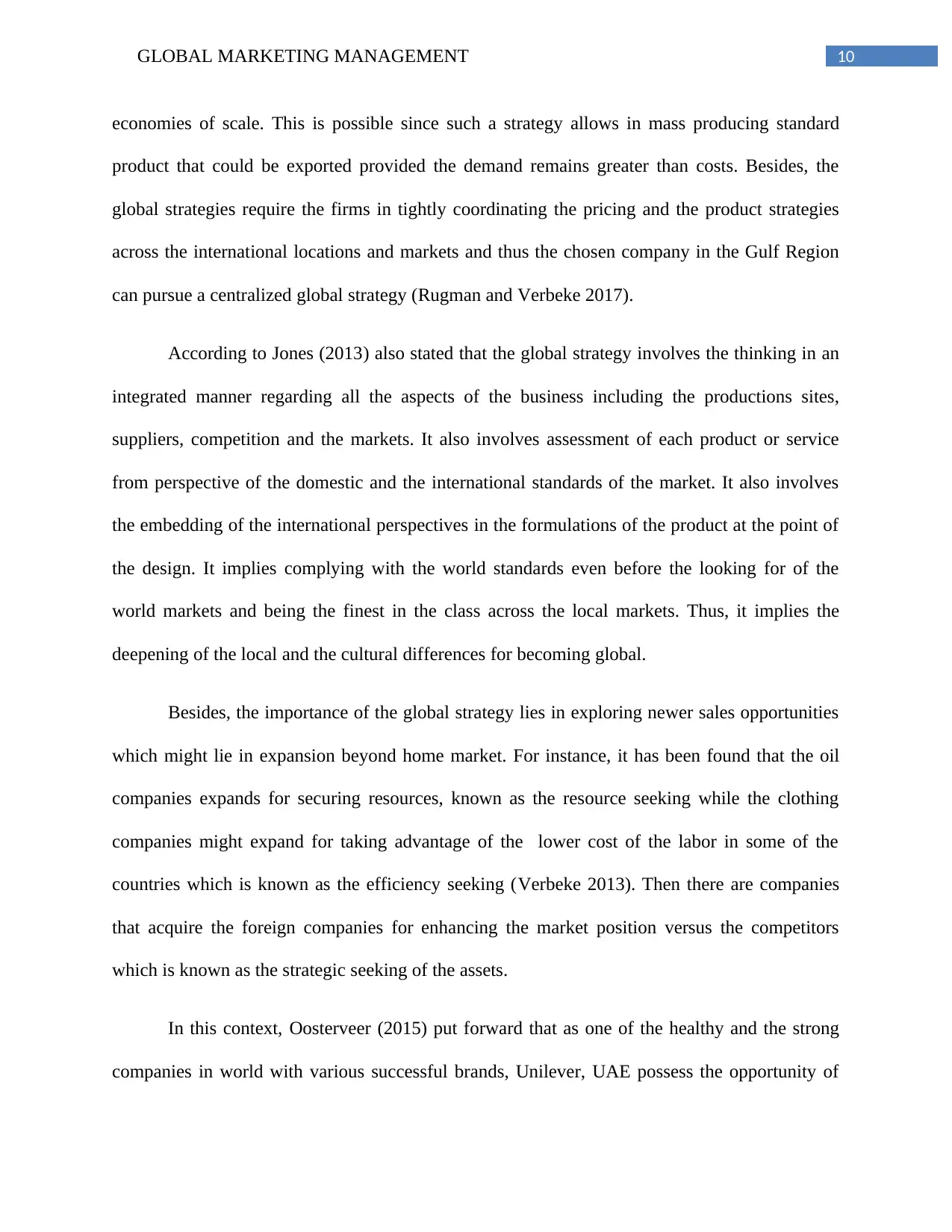
10GLOBAL MARKETING MANAGEMENT
economies of scale. This is possible since such a strategy allows in mass producing standard
product that could be exported provided the demand remains greater than costs. Besides, the
global strategies require the firms in tightly coordinating the pricing and the product strategies
across the international locations and markets and thus the chosen company in the Gulf Region
can pursue a centralized global strategy (Rugman and Verbeke 2017).
According to Jones (2013) also stated that the global strategy involves the thinking in an
integrated manner regarding all the aspects of the business including the productions sites,
suppliers, competition and the markets. It also involves assessment of each product or service
from perspective of the domestic and the international standards of the market. It also involves
the embedding of the international perspectives in the formulations of the product at the point of
the design. It implies complying with the world standards even before the looking for of the
world markets and being the finest in the class across the local markets. Thus, it implies the
deepening of the local and the cultural differences for becoming global.
Besides, the importance of the global strategy lies in exploring newer sales opportunities
which might lie in expansion beyond home market. For instance, it has been found that the oil
companies expands for securing resources, known as the resource seeking while the clothing
companies might expand for taking advantage of the lower cost of the labor in some of the
countries which is known as the efficiency seeking (Verbeke 2013). Then there are companies
that acquire the foreign companies for enhancing the market position versus the competitors
which is known as the strategic seeking of the assets.
In this context, Oosterveer (2015) put forward that as one of the healthy and the strong
companies in world with various successful brands, Unilever, UAE possess the opportunity of
economies of scale. This is possible since such a strategy allows in mass producing standard
product that could be exported provided the demand remains greater than costs. Besides, the
global strategies require the firms in tightly coordinating the pricing and the product strategies
across the international locations and markets and thus the chosen company in the Gulf Region
can pursue a centralized global strategy (Rugman and Verbeke 2017).
According to Jones (2013) also stated that the global strategy involves the thinking in an
integrated manner regarding all the aspects of the business including the productions sites,
suppliers, competition and the markets. It also involves assessment of each product or service
from perspective of the domestic and the international standards of the market. It also involves
the embedding of the international perspectives in the formulations of the product at the point of
the design. It implies complying with the world standards even before the looking for of the
world markets and being the finest in the class across the local markets. Thus, it implies the
deepening of the local and the cultural differences for becoming global.
Besides, the importance of the global strategy lies in exploring newer sales opportunities
which might lie in expansion beyond home market. For instance, it has been found that the oil
companies expands for securing resources, known as the resource seeking while the clothing
companies might expand for taking advantage of the lower cost of the labor in some of the
countries which is known as the efficiency seeking (Verbeke 2013). Then there are companies
that acquire the foreign companies for enhancing the market position versus the competitors
which is known as the strategic seeking of the assets.
In this context, Oosterveer (2015) put forward that as one of the healthy and the strong
companies in world with various successful brands, Unilever, UAE possess the opportunity of
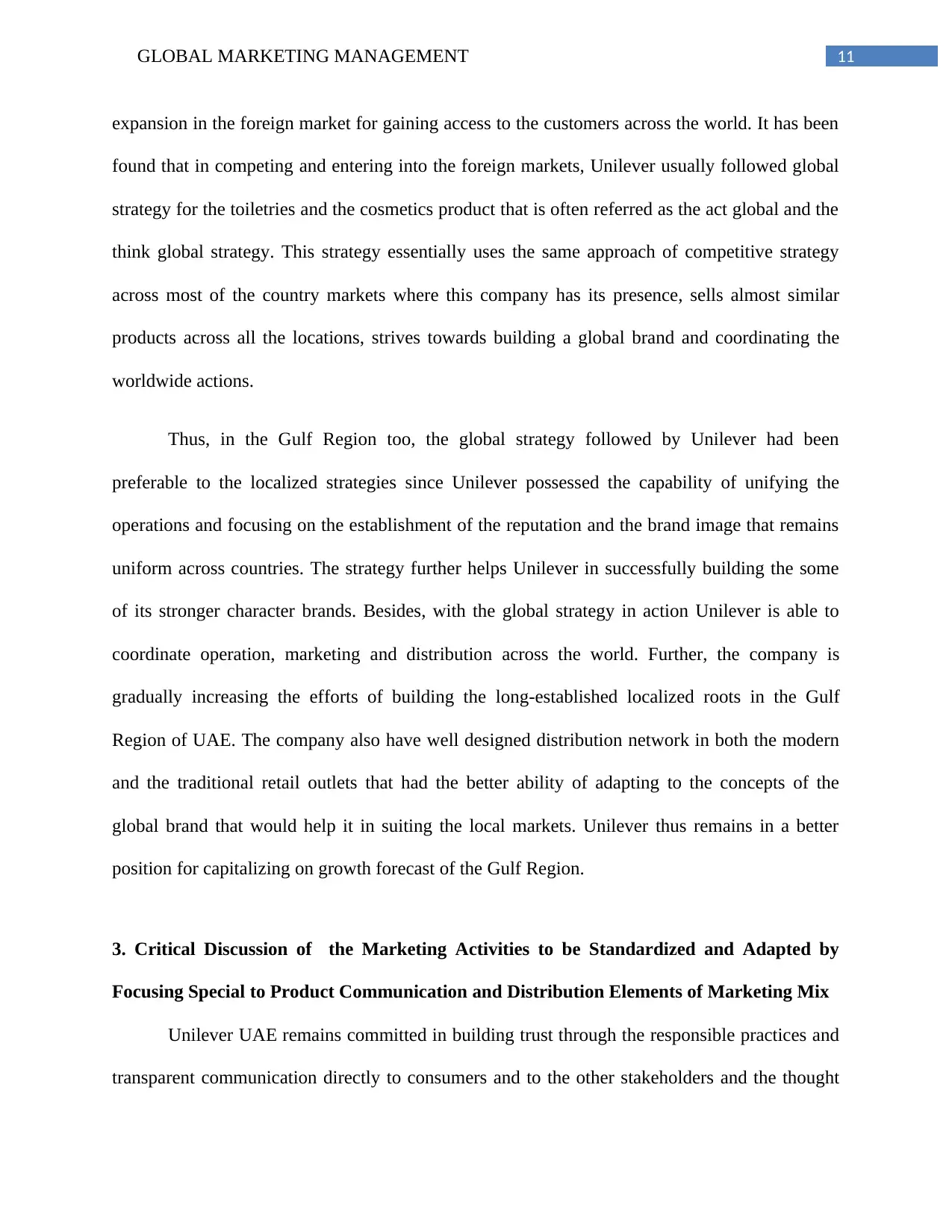
11GLOBAL MARKETING MANAGEMENT
expansion in the foreign market for gaining access to the customers across the world. It has been
found that in competing and entering into the foreign markets, Unilever usually followed global
strategy for the toiletries and the cosmetics product that is often referred as the act global and the
think global strategy. This strategy essentially uses the same approach of competitive strategy
across most of the country markets where this company has its presence, sells almost similar
products across all the locations, strives towards building a global brand and coordinating the
worldwide actions.
Thus, in the Gulf Region too, the global strategy followed by Unilever had been
preferable to the localized strategies since Unilever possessed the capability of unifying the
operations and focusing on the establishment of the reputation and the brand image that remains
uniform across countries. The strategy further helps Unilever in successfully building the some
of its stronger character brands. Besides, with the global strategy in action Unilever is able to
coordinate operation, marketing and distribution across the world. Further, the company is
gradually increasing the efforts of building the long-established localized roots in the Gulf
Region of UAE. The company also have well designed distribution network in both the modern
and the traditional retail outlets that had the better ability of adapting to the concepts of the
global brand that would help it in suiting the local markets. Unilever thus remains in a better
position for capitalizing on growth forecast of the Gulf Region.
3. Critical Discussion of the Marketing Activities to be Standardized and Adapted by
Focusing Special to Product Communication and Distribution Elements of Marketing Mix
Unilever UAE remains committed in building trust through the responsible practices and
transparent communication directly to consumers and to the other stakeholders and the thought
expansion in the foreign market for gaining access to the customers across the world. It has been
found that in competing and entering into the foreign markets, Unilever usually followed global
strategy for the toiletries and the cosmetics product that is often referred as the act global and the
think global strategy. This strategy essentially uses the same approach of competitive strategy
across most of the country markets where this company has its presence, sells almost similar
products across all the locations, strives towards building a global brand and coordinating the
worldwide actions.
Thus, in the Gulf Region too, the global strategy followed by Unilever had been
preferable to the localized strategies since Unilever possessed the capability of unifying the
operations and focusing on the establishment of the reputation and the brand image that remains
uniform across countries. The strategy further helps Unilever in successfully building the some
of its stronger character brands. Besides, with the global strategy in action Unilever is able to
coordinate operation, marketing and distribution across the world. Further, the company is
gradually increasing the efforts of building the long-established localized roots in the Gulf
Region of UAE. The company also have well designed distribution network in both the modern
and the traditional retail outlets that had the better ability of adapting to the concepts of the
global brand that would help it in suiting the local markets. Unilever thus remains in a better
position for capitalizing on growth forecast of the Gulf Region.
3. Critical Discussion of the Marketing Activities to be Standardized and Adapted by
Focusing Special to Product Communication and Distribution Elements of Marketing Mix
Unilever UAE remains committed in building trust through the responsible practices and
transparent communication directly to consumers and to the other stakeholders and the thought
⊘ This is a preview!⊘
Do you want full access?
Subscribe today to unlock all pages.

Trusted by 1+ million students worldwide
1 out of 21
Related Documents
Your All-in-One AI-Powered Toolkit for Academic Success.
+13062052269
info@desklib.com
Available 24*7 on WhatsApp / Email
![[object Object]](/_next/static/media/star-bottom.7253800d.svg)
Unlock your academic potential
Copyright © 2020–2025 A2Z Services. All Rights Reserved. Developed and managed by ZUCOL.



